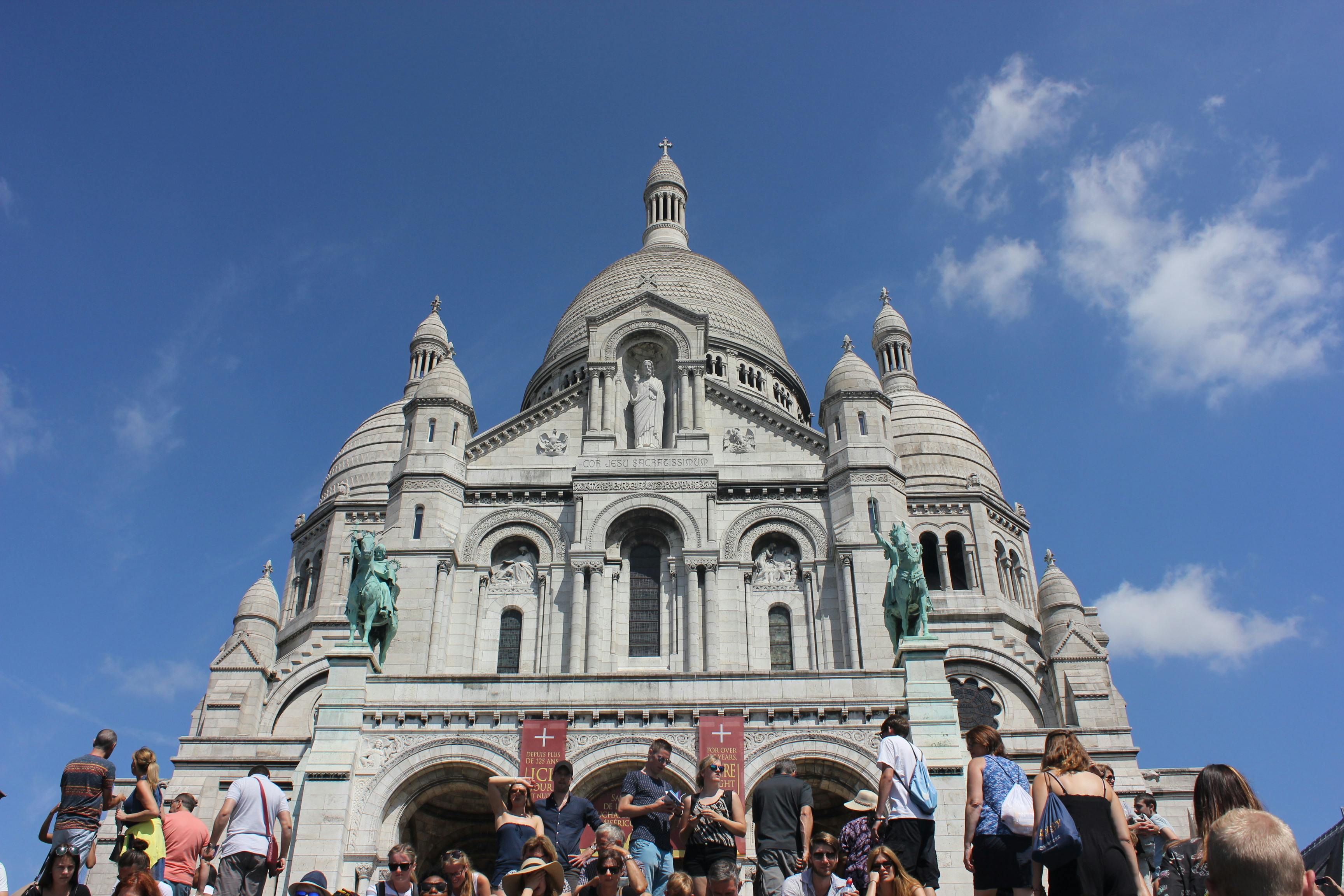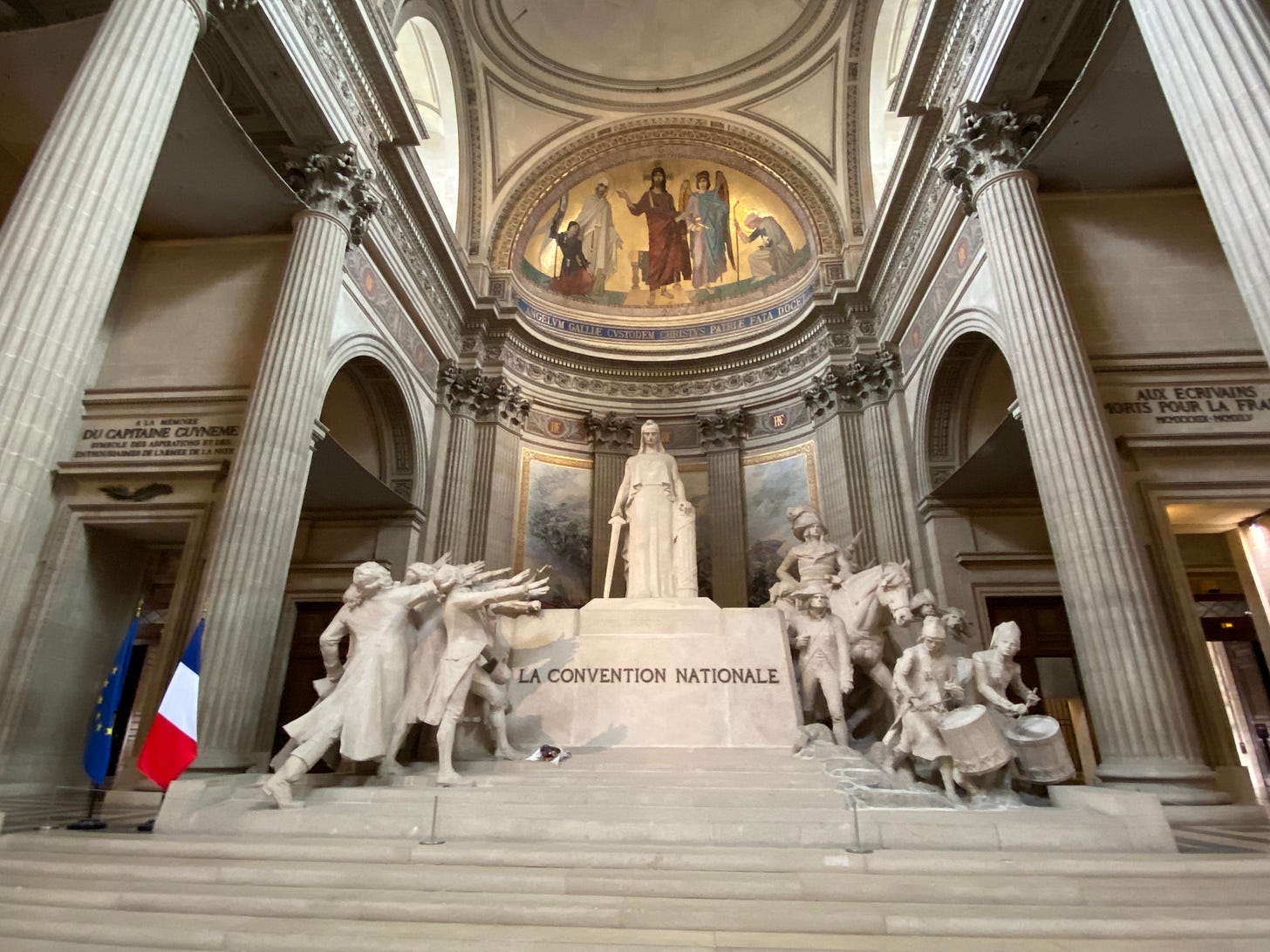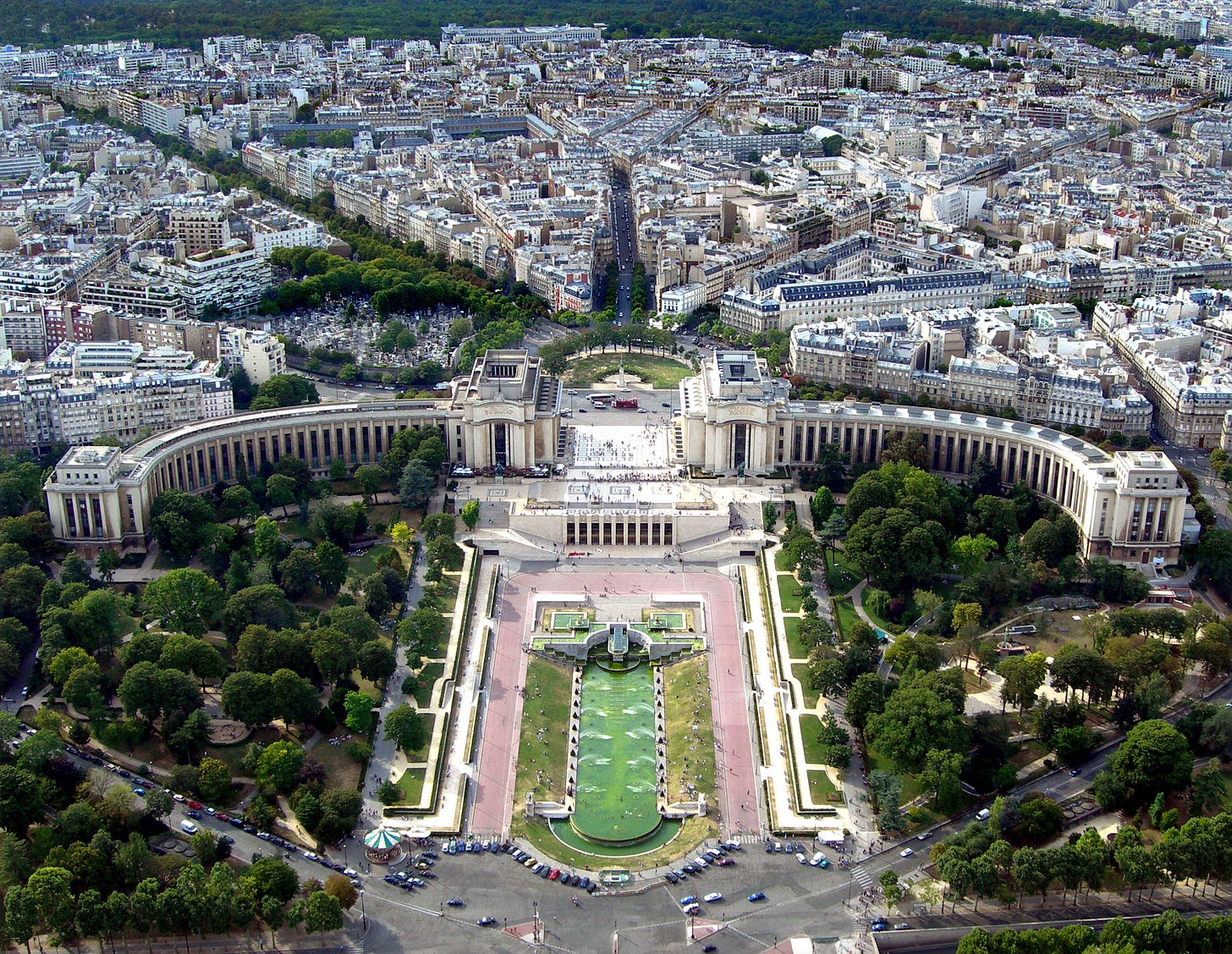
Traveling Through History
Issue 13 - A Day Tour of Paris
Welcome to our final day in Paris.
With this week’s newsletter I am trying something a bit different.
Just like the Hop-On, Hop-Off buses take you to major places in cities, we will be doing a walking/bus/metro tour to tick off a few more places before our trip to Paris ends.
I hope that you have enjoyed our time in Paris and that it has been as much fun for you as it has been for me!
We are going to be busy today! So put on your best walking shoes and let’s go!
Michelle
Savvy Travel Historian
Our tour starts at the Pantheon so let’s meet out the front to start our day.

Beginning its life as the Church of Sanite-Genevièe, the Pantheon has undergone no less than six different designations during its lifetime. Designed by Jacques-Germain Soufflot, the first stone was laid by King Louis XV in 1764 and completed in 1790 by one Soufflot’s students and a colleague, as he died before it was finished.

Before the Eiffel Tower was built, the Pantheon was the tallest structure in Paris. Laid out in a Greek cross formation, the building has a triple dome on top.

The building became a national necropolis in 1791, the year in which Voltaire was buried there but only for ‘great men’ of France.

The crypt has a large number of tunnels with rooms off of each side, containing French luminaries. Each burial plot sis of a uniform design. The following are a few examples.
Marie & Pierre Curie are there together, with Marie only being interned (on her own merit) in 1995! – they were both Scientists.

Victor Hugo, acclaimed French writer for such novels as ‘The Hunchback of Notre-Dame’ and ‘Les Misérables’.

Louis Braille, the inventor of the reading and writing system for visually impaired people.

There are many others but the criteria for ‘pantheonization’ is strict and must be agreed upon by a vote of Parliament.

The instalment in 1911 of the national monument to the Republic, the National Convention statue from the ‘third’ republic, takes its inspiration from the first republic of the original French Revolution.
https://www.paris-pantheon.fr/en
Open every day from 10am
https://www.paris-pantheon.fr/en/visiter/practical-information
As we leave the Pantheon to go to our next stop, Sainte Chapelle, walk past the Sorbonne on the way.


Created in 1253 as one of the first universities in Europe, Robert de Sorbon (after whom it is named), was Chaplin and confessor to King Louis IX. The reputation of the Sorbonne is synonymous with what a high ranking, prestigious university should be.
The site has been a place of learning continuously since created, save for the turmoil during the French Revolution. From 1801 it started housing simple art workshops and during the restoration, Louis XVIII restored the buildings to a full educational centre.

It is only a short walk from the Sorbonne to Les Écoles bus stop to catch either the #21 or #38 and get off at Cité – Palais de Justice.

The ‘Holy Chapel’ known as Sainte Chapelle is a royal chapel built in the gothic style within the Palais de la Cité, which was the office residence of the Kings of France until the 14thC.

Construction began around 1238 by King Louis IX (who was later canonised as Saint Louis), to house his collection of relics of Christ, namely the crown of thorns and splinters of the crucifixion cross.

Upstairs inside the chapel is absolutely breath-taking. The building is almost entirely stained-glass windows. Each panel representing various books of the Bible and the story of Christ’s passion.
The chapel was a prime target for vandalism during the French Revolution which sought to tear down anything to do with religion and royalty. The relics were removed (but later placed in Notré-Dame) and statues and iconography smashed.

As mentioned in Issue 11, some of the recovered panels are now on display in the Musée du Cluny. The Louvre is currently looking after the relics until the Cathedral is rebuilt after the 2019 fire.
https://www.sainte-chapelle.fr/
Open every day from 9am.
https://tickets.monuments-nationaux.fr/fr-FR/familles?site=2035141861660400306

For our 2nd Church visit of the day, we are walking back across the river to St Michel Metro station (Line 4) and getting off at ‘Marcedet Poissonniers’ station and changing to Line 12 and alighting at ‘Abbesses’ in the Montmartre District.

We walk from Abbesses Station down Rue Yvonne Le Tac towards the Funiculaire to take us up the hill to Sacré Cœur.

The Funiculaire was opened in 1900 and upgraded in 1935 & 1991. It is an inclined transport system that takes 1.5 minutes to get to the top.

Just a short walk after getting off and you are in front of the Basilica.

Built during the late 1800s and consecrated in 1919, the Sacred Heart of Jesus Church is a minor (but beautiful) basilica in the Montmartre District of Paris.

When we visited in 2016, the above banner was displayed at the front. Now, the timeframe would be over 130 years that people have been praying here, day & night.

It is worth paying the entrance free for the 300 step climb up the Dome, as the views from the hill over Paris are spectacular.


https://www.sacre-coeur-montmartre.com/english/
Open every day from 6:30am and climbing the Dome from 10:30am.
Entry to the basilica is free but there is a small charge to climb the Dome.

There are several ways to get back down, to walk through the Montmartre District on our way to the Moulin Rouge.

You can either walk down the hill or catch the Funiculaire down. Then we are going to walk down Rue Des Abbesses, the turn left on the corner of Rue Lepic, to walk past the cafés and shops until we eventually come upon the Moulin Rouge.

Along the way, we will see artists that can paint your picture, or craft stalls where you can pick up souvenirs.
If you are hungry, this is a good area to stop for lunch.


The Moulin Rouge is certainly a different place during the day, than it is at night. Moulin Rouge means ‘Red Mill’ and the venue is a cabaret club offering three shows per day.
A dinner show at 7pm and two other performances at 9pm and 11pm.

Best known for the modern form of the Can-Can, the venue began its performances in 1889. The original building was destroyed by fire in early 1915 and would not open again for 10 years.

https://www.moulinrouge.fr/en/homepage/
https://reservations.moulinrouge.fr/en?_ga=2.102157057.168629004.1693647859-1183149115.1693647859
Time to get moving again. This time we will take the bus to the Trocadéro.
Catch bus #30 for the journey at stop ‘Blanche’, just east of the venue, passing around the Arc du Triomphe on the way!

The site of a former palace by the same name, Trocadéro plaza gives one of the best viewing platforms of the Eiffel Tower in Paris. The iconic image of Hitler with the tower in the background was taken from this spot.
The site is now occupied by the Palais de Chaillot, which houses two museums.

At night, the Tower’s light show, can best be seen from this vantage point.

There are extensive gardens to explore if the weather is nice and places to eat, get ice-cream and pick up a tourist souvenir.
The view of it from the Eiffel Tower shows the scale of how big the area is.

https://parisjetaime.com/eng/culture/jardins-du-trocadero-p933
Our final stop for the day is Notré Dame.
To maximise our experience, this time we will take the bus, so that we can see the city on the way. You can catch the #63 bus from right out the front from Metro exit #1 when you arrived at Torcadéro

Get off at stop ‘Dante’ and walk to the Cathedral.

If you want to pop into the Shakespeare & Company Bookshop, now’s the time as it is just to the left, before you cross the river.

Notré Dame de Paris, which means ‘Our Lady of Paris’, was started in 1163 and completed around 1260. We were very lucky to see the Cathedral in 2016, before it was devastated by fire in April 2019.

It is widely recognised as the symbol of Paris, which is why the World watched in horror as images of it on fire were beamed around the globe.
The French Government have committed to reconstructing the Cathedral as it was before the fire and this restoration work is expected to be completed in late 2024.

While it remains closed to visitors, the Archaeological Crypt of Paris has recently reopened and is worth visiting.

https://www.notredamedeparis.fr/
https://parisjetaime.com/eng/tickets/archaeological-crypt-of-paris-m9000702
Time for a well-earned rest as we finish our day looking over the Seine as we make our way back to our accommodation.


Michelle is a speaker, author, content marketer, historian and mother of 3 boys.
After 25 years in business and as the ‘Content Marketing Queen’ for the past 12 years, she has helped countless small businesses understand and develop their content strategies and focus on a customer first approach.
Savvy Travel Historian is her passion project, and her weekly newsletter is available on Substack, Paragraph and Mirror. The latter two allows you to collect each Issue as an NFT.
Michelle is co-host of the Web3 By Three Podcast, a weekly show which talks about current stories in the Web3 space and how it applies to B2B marketing, sales and operations. The show is recorded live every Wednesday at 4pm EST/ 9pm UTC on LinkedIn, YouTube & Bolt+.
You can follow Michelle in these places:
Savvy Travel Historian Instagram
